Rococo, less commonly roccoco, or "Late Baroque", is an early to late 18th-century French artistic movement and style, affecting many aspects of the arts including painting, sculpture, architecture, interior design, decoration, literature, music, and theatre. It developed in the early 18th century in Paris, France as a reaction against the grandeur, symmetry, and strict regulations of the previous Baroque style, especially of the Palace of Versailles, until it was redone. Rococo artists and architects used a more jocular, florid, and graceful approach to the Baroque. Their style was ornate and used light colours, asymmetrical designs, curves, and gold. Unlike the political Baroque, the Rococo had playful and witty themes. The interior decoration of Rococo rooms was designed as a total work of art with elegant and ornate furniture, small sculptures, ornamental mirrors, and tapestry complementing architecture, reliefs, and wall paintings.
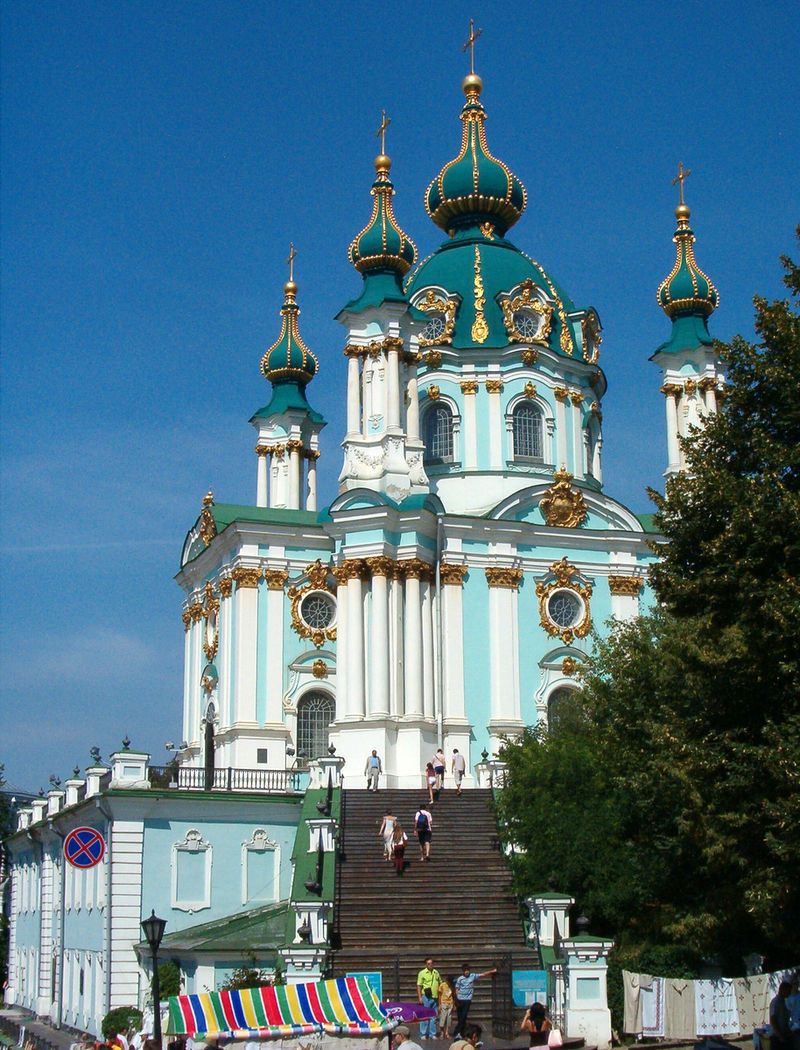
St. Andrew's Church in Kiev, 1744–1767,
designed by Francesco Bartolomeo Rastrelli
By the end of the 18th century, Rococo was largely replaced by the Neoclassic style. In 1835 the Dictionary of the French Academy stated that the word Rococo "usually covers the kind of ornament, style and design associated with Louis XV's reign and the beginning of that of Louis XVI". It includes therefore, all types of art from around the middle of the 18th century in France. The word is seen as a combination of the French rocaille (stone) and coquilles (shell), due to reliance on these objects as decorative motifs. The term may also be a combination of the Italian word "barocco" (an irregularly shaped pearl, possibly the source of the word "baroque") and the French "rocaille" (a popular form of garden or interior ornamentation using shells and pebbles) and may describe the refined and fanciful style that became fashionable in parts of Europe in the 18th century.

Zwinger in Dresden
The Rococo love of shell-like curves and focus on decorative arts led some critics to say that the style was frivolous or merely modish. When the term was first used in English in about 1836, it was a colloquialism meaning "old-fashioned". The style received harsh criticism and was seen by some to be superficial and of poor taste, especially when compared to neoclassicism; despite this, it has been praised for its aesthetic qualities, and since the mid-19th century, the term has been accepted by art historians. While there is still some debate about the historical significance of the style to art in general, Rococo is now widely recognized as a major period in the development of European art.

Rococo-style House of the Good Shepherd in Bratislava (Slovakia) -
an example of the 18th century bourgeoisie house
Historical development
Although Rococo is usually thought of as developing first in the decorative arts and interior design, its origins lie in the late Baroque architectural work of Borromini (1599-1667) mostly in Rome and Guarini (1624-1683) mostly in Northern Italy but also in Vienna, Prague, Lisbon, and Paris. Italian architects of the late Baroque/early Rococo were wooed to Catholic (Southern) Germany, Bohemia and Austria by local princes, bishops and prince-bishops. Inspired by their example, regional families of Central European builders went further, creating churches and palaces that took the local German Baroque style to the greatest heights of Rococo elaboration and sensation. An exotic but in some ways more formal type of Rococo appeared in France where Louis XIV's succession brought a change in the court artists and general artistic fashion. By the end of the king's long reign, rich Baroque designs were giving way to lighter elements with more curves and natural patterns. These elements are obvious in the architectural designs of Nicolas Pineau. During the Régence, court life moved away from Versailles and this artistic change became well established, first in the royal palace and then throughout French high society.

Igreja de São Francisco de Assis in São João del Rei,
1749-1774, by the Brazilian master Aleijadinho
The delicacy and playfulness of Rococo designs is often seen as perfectly in tune with the excesses of Louis XV's reign. The 1730s represented the height of Rococo development in France. The style had spread beyond architecture and furniture to painting and sculpture, exemplified by the works of Antoine Watteau and François Boucher. Rococo still maintained the Baroque taste for complex forms and intricate patterns, but by this point, it had begun to integrate a variety of diverse characteristics including asymmetric compositions. The Rococo style was spread by French artists and engraved publications.

François Boucher, Le Déjeuner, (1739, Louvre), shows a rocaille interior
of a French bourgeois family in the 18th century.
The porcelain statuette and vase add a touch of chinoiserie
In Great Britain, Rococo was always thought of as the "French taste" and was never widely adopted as an architectural style, although its influence was strongly felt in such areas as silverwork, porcelain, and silks, and Thomas Chippendale transformed British furniture design through his adaptation and refinement of the style. William Hogarth helped develop a theoretical foundation for Rococo beauty. Though not intentionally referencing the movement, he argued in his Analysis of Beauty (1753) that the undulating lines and S-curves prominent in Rococo were the basis for grace and beauty in art or nature (unlike the straight line or the circle in Classicism). William Hogarth used his talent to criticise the upper class.[8] The development of Rococo in Great Britain is considered to have been connected with the revival of interest in Gothic architecture early in the 18th century.
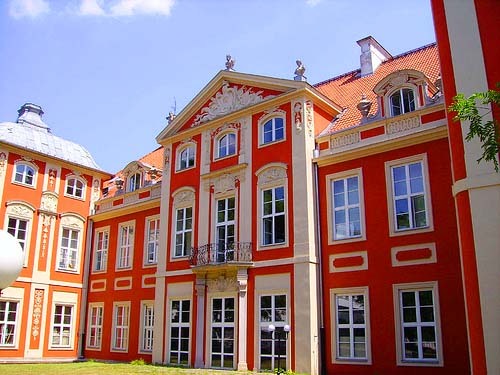
Czapski Palace in Warsaw, 1712–1721,
reflects rococo's fascinations of oriental architecture
The beginning of the end for Rococo came in the early 1760s as figures like Voltaire and Jacques-François Blondel began to voice their criticism of the superficiality and degeneracy of the art. Blondel decried the "ridiculous jumble of shells, dragons, reeds, palm-trees and plants" in contemporary interiors.[9] By 1785, Rococo had passed out of fashion in France, replaced by the order and seriousness of Neoclassical artists like Jacques-Louis David. In Germany, late 18th century Rococo was ridiculed as Zopf und Perücke ("pigtail and periwig"), and this phase is sometimes referred to as Zopfstil. Rococo remained popular in the provinces and in Italy, until the second phase of neoclassicism, "Empire style", arrived with Napoleonic governments and swept Rococo away. There was a renewed interest in the Rococo style between 1820 and 1870. The British were among the first to revive the "Louis XIV style" as it was miscalled at first, and paid inflated prices for second-hand Rococo luxury goods that could scarcely be sold in Paris. But prominent artists like Eugène Delacroix and patrons like Empress Eugénie also rediscovered the value of grace and playfulness in art and design.
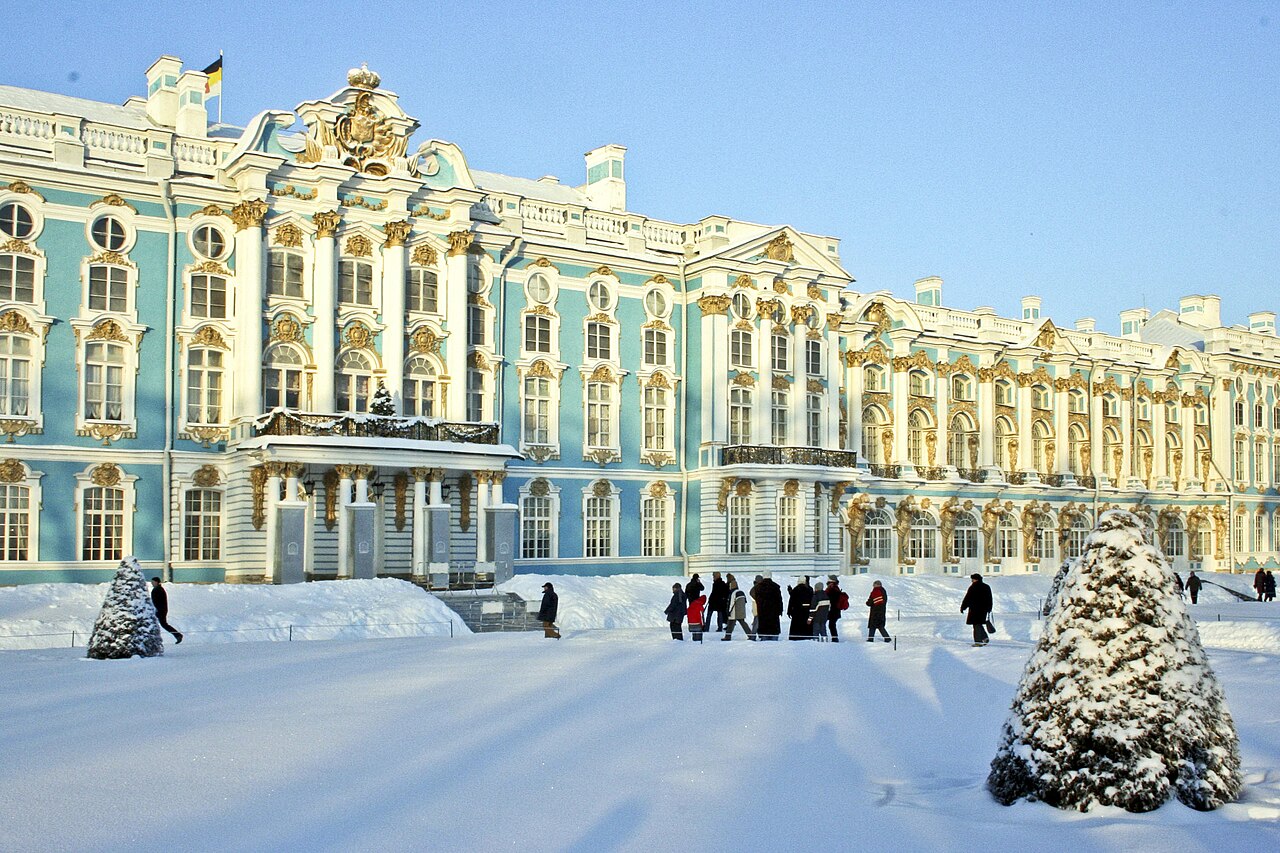
The Catherine Palace in Tsarskoye Selo
is one of the northernmost Rococo buildings
Architecture
Rococo architecture, as mentioned above, was a lighter, more graceful, yet also more elaborate version of Baroque architecture, which was ornate and austere. Whilst the styles were similar, there are some notable differences between both Rococo and Baroque architecture, one of them being symmetry, since Rococo emphasised the asymmetry of forms, whilst Baroque was the opposite. The styles, despite both being richly decorated, also had different themes; the Baroque, for instance, was more serious, placing an emphasis on religion, and was often characterized by Christian themes (as a matter of fact, the Baroque began in Rome as a response to the Protestant Reformation); Rococo architecture was an 18th-century, more secular, adaptation of the Baroque which was characterized by more light-hearted and jocular themes. Other elements belonging to the architectural style of Rococo include numerous curves and decorations, as well as the usage of pale colours.

The Queluz National Palace in Portugal was one of
the last Rococo buildings to be built in Europe
There are numerous examples of Rococo buildings as well as architects. Amongst the most famous include the Catherine Palace, in Russia, the Queluz National Palace in Portugal, the Augustusburg and Falkenlust Palaces, Brühl, the Chinese House (Potsdam), the Charlottenburg Palace in Germany, as well as elements of the Château de Versailles in France. Architects who were renowned for their constructions using the style include Francesco Bartolomeo Rastrelli, an Italian architect who worked in Russia and who was noted for his lavish and opulent works, Philip de Lange, who worked in both Danish and Dutch Rococo architecture, or Matthäus Daniel Pöppelmann, who worked in the late Baroque style and who contributed to the reconstruction of the city of Dresden, in Germany. Rococo architecture also brought significant changes to the building of edifices, placing an emphasis on privacy rather than the grand public majesty of Baroque architecture, as well as improving the structure of buildings in order to create a more healthy environment.

The Rococo Branicki Palace in Białystok,
sometimes referred to as the "Polish Versailles"
Interior design
Solitude Palace in Stuttgart and Chinese Palace in Oranienbaum, the Bavarian church of Wies and Sanssouci in Potsdam are examples of how Rococo made its way into European architecture. In those Continental contexts where Rococo is fully in control, sportive, fantastic, and sculptured forms are expressed with abstract ornament using flaming, leafy or shell-like textures in asymmetrical sweeps and flourishes and broken curves; intimate Rococo interiors suppress architectonic divisions of architrave, frieze, and cornice for the picturesque, the curious, and the whimsical, expressed in plastic materials like carved wood and above all stucco (as in the work of the Wessobrunner School). Walls, ceiling, furniture, and works of metal and porcelain present a unified ensemble. The Rococo palette is softer and paler than the rich primary colors and dark tonalities favored in Baroque tastes.
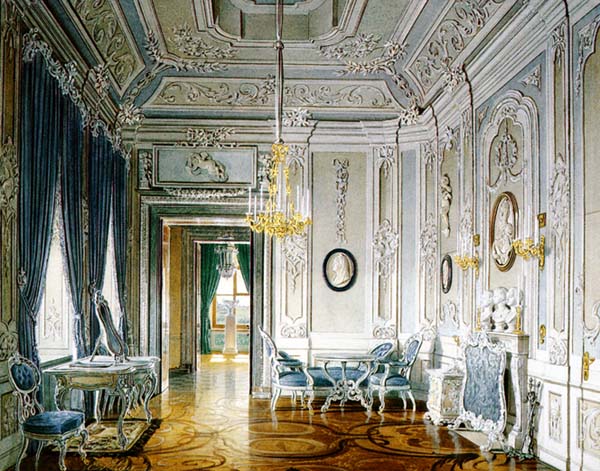
A Rococo interior in Gatchina
A few anti-architectural hints rapidly evolved into full-blown Rococo at the end of the 1720s and began to affect interiors and decorative arts throughout Europe. The richest forms of German Rococo are in Catholic Germany (illustration, above). Rococo plasterwork by immigrant Italian-Swiss artists like Bagutti and Artari is a feature of houses by James Gibbs, and the Franchini brothers working in Ireland equalled anything that was attempted in Great Britain.

Rococo staircase in Gruber Mansion, Slovenia
Inaugurated in some rooms in Versailles, it unfolds its magnificence in several Parisian buildings (especially the Hôtel Soubise). In Germany, Belgian and German artists (Cuvilliés, Neumann, Knobelsdorff, etc.) effected the dignified equipment of the Amalienburg near Munich, and the castles of Würzburg, Potsdam, Charlottenburg, Brühl, Bruchsal, Solitude (Stuttgart), and Schönbrunn. In Great Britain, Hogarth's set of paintings forming a melodramatic morality tale titled Marriage à la Mode, engraved in 1745, shows the parade rooms of a stylish London house, in which the only rococo is in plasterwork of the salon's ceiling. Palladian architecture is in control. Here, on the Kentian mantel, the crowd of Chinese vases and mandarins are satirically rendered as hideous little monstrosities, and the Rococo wall clock is a jumble of leafy branches. In general, Rococo is an entirely interior style, because the wealthy and aristocratic moved back to Paris from Versailles. Paris was already built up and so rather than engaging in major architectural additions, they simply renovated the interiors of the existing buildings.

Integrated rococo carving, stucco and fresco at Zwiefalten
Kiến trúc Rococo là một phong cách nghệ thuật và thiết kế nội thất của Pháp thế kỷ 18. Đây là phong cách kiến trúc được sử dụng phổ biến ở thời của hoàng hậu Marie Antoinette. Các phòng thuộc phong cách Rococo thường được thiết kế thành một sản phẩm nghệ thuật tổng thể với vật dụng trang trí lộng lẫy và thanh tao, những vật phẩm điêu khắc nhỏ, những chiếc gương trang trí, thảm thêu, ngoài ra nó còn được bổ sung bởi những bước tranh tường tinh tế.
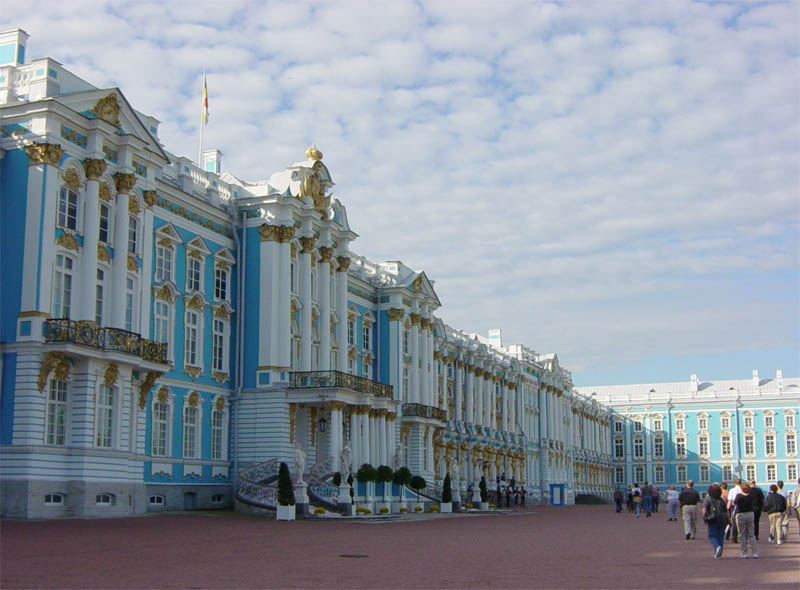
Mặt phía bắc của Cung điện Catherine ở Tsarskoye Selo -
sân dành cho xe ngựa đi vào: tất cả các họa tiết đều được
trang trí bằng vàng cho tới năm 1773, khi Ekaterina II
thay thế các họa tiết mạ vàng bằng nước sơn màu oliu xám
Từ Rococo là sự kết hợp của từ rocaille (vỏ) trong tiếng Pháp và từ barocco trong tiếng Ý. Đây là phong cách kiến trúc thường có các đường cong trang trí dạng vỏ và thường tập trung vào những đường nét họa tiết trang trí, do vậy nên một vài nhà phê bình nghệ thuật đã sử dụng từ này để ngụ ý chỉ rằng đây là một phong cách phù phiếm và chỉ coi nó như một trào lưu thời trang; khi từ Rococo được sử dụng lần đầu ở Anh năm 1836, nghĩa thông tục của nó là "lạc hậu" (old-fashioned). Dù vậy thì từ giữa thế kỷ 19, từ này đã được chấp nhận bởi các nhà sử học về nghệ thuật. Trong khi hiện nay vẫn có một số tranh luận về tầm ảnh hưởng của phong cách kiến trúc này tới nghệ thuật nói chung thì Rococo hiện vẫn được thừa nhận là một thời kỳ quan trọng trong lịch sử phát triển của kiến trúc châu Âu.

Electoral Palace of Trier
Rococo là khái niệm mà các nhà phê bình nghệ thuật thế kỷ 19 sử dụng để mô tả những công trình trang trí kiến trúc và đồ gỗ đã được phát triển từ trường phái Baroque và trở thành mốt tại Pháp vào những năm 1720 sau khi nhà vua Louis XIV chết. Rococo đã phát triển một cách đại chúng, phổ biến khắp châu Âu. Trong kiến trúc, phong cách này phần lớn giới hạn trong trang trí các mặt đứng, facades bên ngoài. Rococo thể hiện đầy đủ nhất phong cách trang nhã của nó tại những công trình trang trí đồ gỗ, tường nhà của những biệt thự, nhà riêng của cư dân Paris. Tại Đức và Áo, phong cách Rococo được ứng dụng vào những công trình nội thất kiểu Baroc trong các nhà thờ và cung điện. Rococo có nguồn gốc từ sự kết hợp giữa Baroque và trang trí vườn non bộ kiểu Pháp, đá và vỏ sò được sử dụng để trang trí kiến trúc ngoại thất nhà vườn.

Eszterháza in Fertőd, Hungary, 1720–1766,
sometimes called the "Hungarian Versailles"

No comments:
Post a Comment